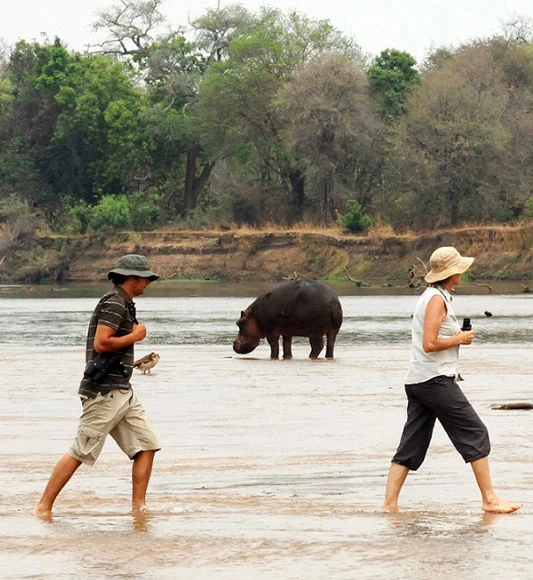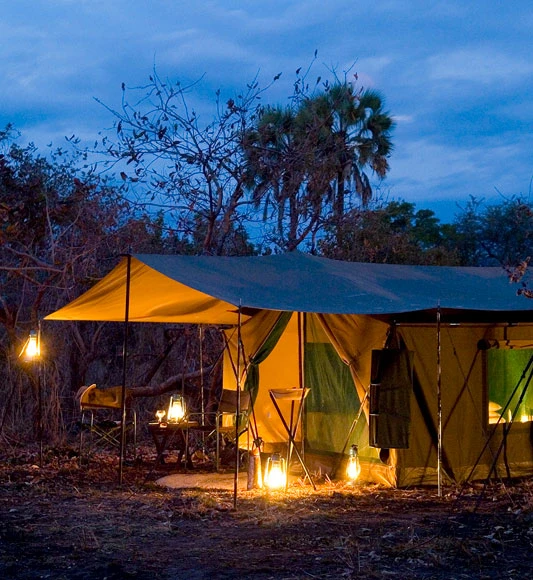
(©Robin Pope Safaris)

(©Robin Pope Safaris)
Zambia is the birthplace of walking safaris and is known for its exceptional guiding and wildlife viewing. My walking safari in Zambia takes me from the South Luangwa National Park to the lesser-visited but equally wonderful North Luangwa National Park.
Walking Safaris in South Luangwa National Park
The South Luangwa National Park is a veritable treasure trove of abundant wildlife which is concentrated around the Luangwa River and its oxbow lagoons. This renowned predator playground is home to a sizeable leopard population and sightings of this elusive big cat are frequent. You’ll also find healthy elephant and hippo populations, rich birdlife and the endemic Thornicroft’s giraffe living here.
The majority of walking safaris in South Luangwa involve walking between camps and spending a night or two in mobile fly camps en route. However, I recommend spending a few nights in a comfortable permanent tented camp before embarking on your walking adventure.
Accessing the park and my first camp involves an hour’s drive from Mfuwe International Airport through Mfuwe village to the Nsefu sector. I inhale the strong scent of wild sage and elephant grasses and enjoy watching the activities of the locals going about their day as I pass through. Travelling in September during one of the driest months, I am surprised by how much is still in leaf and bloom. From the heady scent of wild jasmine to the woolly caper bush (a favourite for kudu, giraffe, impala, buffalo and a host of other browsers), the beautifully perfumed flowers are perfect for birds to pollinate.
My first night is spent at a small eco-friendly bush camp overlooking the Luangwa River. Sitting on my verandah, I can hear hippos serenading each other at the water’s edge from a mile away. The camp is entirely electric and runs on solar energy with hot water coming from a geyser. I wake with the sunrise and spend three hours with my knowledgeable guide, identifying hippo highways and elephant trails, inspecting the tiny prints of elephant shrew and the dainty indentations of impala.
The next few days are spent walking between mobile camps. Sleeping in a tent is wonderful as the night sounds are so much closer and clearer through the gauze windows. The breeze wafts gently through, bringing with it the fragrant smells of the plants and wild herbs with the morning dew. I almost feel like I am in a scented garden!
Positioned alongside the usually dry Luwi River, one of my favourite camps to visit is Nsolo. Guest accommodation is in just four reed and thatch cottages with timber floors and bamboo latticed windows. I spend time on the raised veranda with my binoculars and spot puku, baboons and monkeys drinking from the riverbed.
Set on the banks of the Mwamba River, I also fell in love with Mwaba Camp. Built with simplicity and style, it provides an intimate and personal experience. What makes it so special though is the extensive network of exclusive photographic hides. You can also spend the night on the Numbwa Star Bed, a comfortable sleeping platform with a double bed and wash basin – the perfect opportunity to immerse yourself in the African bush, gazing up at the star-studded sky while listening to the nocturnal noises of the wild.
Highlights of my Zambia walking safari

(©Robin Pope Safaris)

(©Robin Pope Safaris)

(©Mwaleshi Camp)

(©Robin Pope Safaris)

(©Robin Pope Safaris)
"My guide is a mine of information, pointing out a pair of mating lions, an immature martial eagle and several Thornicroft giraffes."
Walking Safaris in North Luangwa National Park
Due to its pristine beauty, the North Luangwa region is my favourite walking area. Just a 40-minute flight from Mfuwe Airport lies Mwaleshi Camp, my base for the next few days. With just four thatched cottages rebuilt annually out of natural materials, en-suite bathrooms open to the stars and uninterrupted views of the spectacular Mwaleshi River, the camp offers a genuine feeling of solitude and seclusion.
Waking with the sunrise, I enjoy breakfast around the fireplace before setting out on a four-hour leisurely morning walk. My guide is a mine of information, pointing out a pair of mating lions, an immature martial eagle and several Thornicroft giraffes. Back at the camp, there’s time for a siesta and I spend many hours in a shaded area overlooking the river bank, observing many separate family groups of elephants wallowing in the waters, as well as Crawshay’s zebra, puku and impala as they come to drink.
We set out again in the afternoon, crossing the river in the early evening whilst a group of elephants crossed it in the opposite direction. We have a close encounter with six lions, including a cub, and spot plenty of hippos, warthog and buffalo. Then it’s back to the camp for sundowners as the sun disappears over the Mwalsehi River.

(©Mwaleshi Camp)

(©Robin Pope Safaris)
When is the best time to embark on a walking safari in Zambia?
The best time of year for a walking safari in Zambia is between May to October. This is the dry season and wildlife tends to congregate around depleting water sources, making animals easier to spot.
The green season (November to March) is a good time for birding as migrant species return. There are fewer tourists and the animals are relaxed, but you need to be prepared for rain. Exploring the rivers by boat is a fantastic option at this time of year.
Whichever time of year you choose, you are sure to have a memorable safari experience. Although a slightly simpler style of safari, it is truly one of the best ways to escape everyday life, decompress and become immersed in the wildlife, sounds and smells of nature.
Looking to follow in Nicola's footsteps?
Related articles





